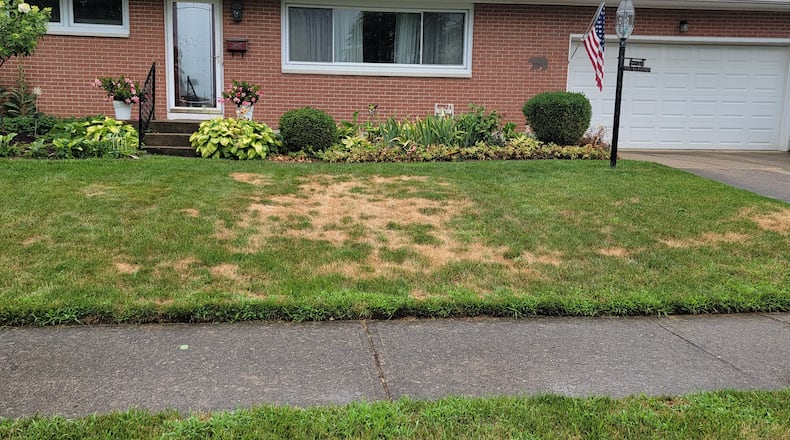However, I got a call from my daughter the other day asking if there was a disease or something hitting lawns. She noticed her neighbor’s and other yards had brown spots.
After asking a few questions, the spots weren’t exactly brown but more of a straw-like color. And after looking at the crowns of the grass plant, she said they were still green.
I am seeing a lot of this around the Miami Valley and it’s not a disease or insect in most cases, but rather a result of the stressed turf.
First, look at the actual grass plant itself. Does it have any spots or damage on the blade other than maybe a ragged tip? The ragged tip is from a dull mower blade.
Brown patch and other turf diseases will show up on the leaf surface as some type of fungal spot. Insect chewing on the leaf blade will be noticeable as well. Rule these out first.
Next, look at the crown of the plant. You may have to pull a plant and take a closer look. Is it green? If there is green tissue, it will recover if you make sure it gets water for the next few weeks.
If you pull the turf plant, does it come up easily or do you have to tug a little to get it out of the ground. If chinch bugs are eating the plant, the blades separate easily from the crown.
You might even look online for some of the common turfgrass diseases and insects to see the symptoms and check them against your turf.
If the turf is more of a gray color than straw color, it’s likely dead and won’t come back. If you rule out all the above, you are likely in good shape.
Where are the yellowish patches? If they are around the driveway, sidewalk, and other places where the temperature is a little higher than in the middle of the lawn, it’s because of the dry stress.
If they are in straight lines, it’s from mower damage. Never mow or walk on drought-stressed turf. It causes this type of damage. Again, if the crown is green, it will recover.
Fertilizing on applying insecticide during a dry spell can cause this discoloration also.
The main take home message is that if the crown is green, the turfgrass plant will recover with normal care. Unless of course, we go right back into a dry spell.
Rain patterns this time of the year are quite crazy and sporadic. We might consider ourselves a little lucky despite the flooding. Those in northeast Ohio are experiencing extremely dry weather. They didn’t get any of the recent rainfall.
Pamela Corle-Bennett is the state master gardener volunteer coordinator and horticulture educator for Ohio State University Extension. Contact her by email at bennett.27@osu.edu.

